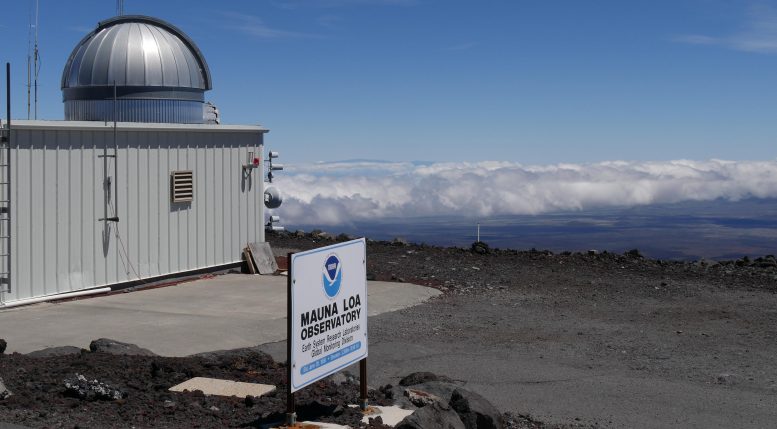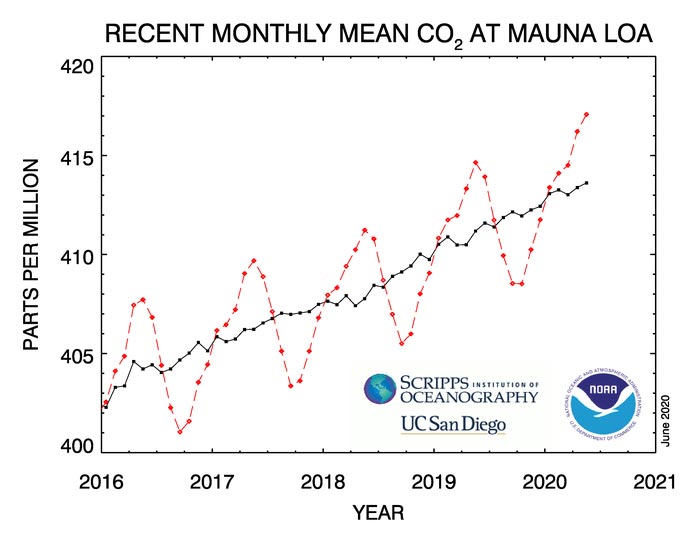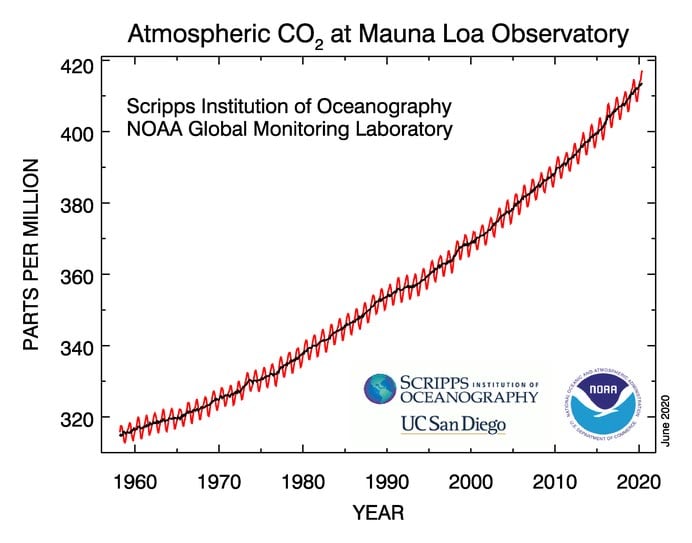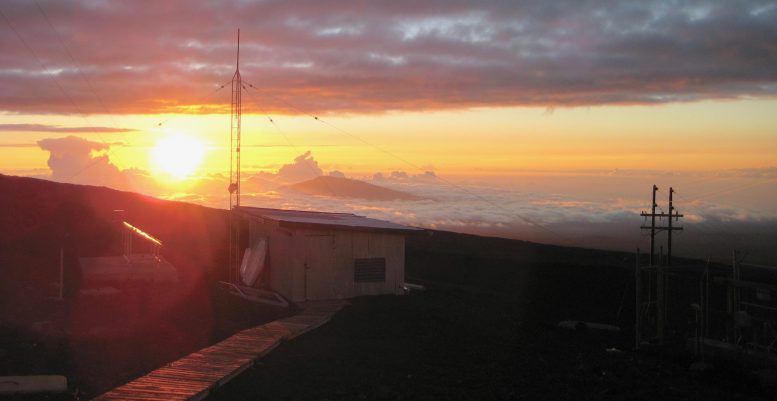https://scitechdaily.com/may-2020-had-the-highest-monthly-atmospheric-co2-reading-ever-recorded/
May 2020 Had the Highest Monthly Atmospheric CO2 Reading Ever Recorded

NOAA”s Mauna Loa observatory, set high on the barren slopes of a volcano in the middle of the Pacific Ocean, is ideally situated to sample air that has not been influenced by local pollution sources or vegetation. Credit: Susan Cobb, NOAA
Rise of carbon dioxide unabated: Seasonal peak reaches 417 parts per million at Mauna Loa observatory
Atmospheric carbon dioxide measured at Mauna Loa Observatory reached a seasonal peak of 417.1 parts per million for 2020 in May, the highest monthly reading ever recorded, scientists from NOAA and Scripps Institution of Oceanography at the University of California San Diego announced on June 4, 2020.
This year’s peak value was 2.4 parts per million (ppm) higher than the 2019 peak of 414.7 ppm recorded in May 2019. NOAA scientists reported a May average of 417.1 ppm. Scripps scientists reported an May average of 417.2 ppm. Monthly carbon dioxide (CO2) values at Mauna Loa first breached the 400 ppm threshold in 2014, and are now at levels not experienced by the atmosphere in several million years.

The carbon dioxide data on Mauna Loa constitute the longest record of direct measurements of carbon dioxide in the atmosphere. C. David Keeling of the Scripps Institution of Oceanography began measurements in 1958 at the NOAA weather station. NOAA started its own CO2 measurements in May of 1974, and they have run in parallel with those made by Scripps since then. Credit: NOAA and Scripps Institution of Oceanography.
“Progress in emissions reductions is not visible in the CO2 record,” said Pieter Tans, senior scientist with NOAA’s Global Monitoring Laboratory. ”We continue to commit our planet — for centuries or longer — to more global heating, sea level rise, and extreme weather events every year.” If humans were to suddenly stop emitting CO2, it would take thousands of years for our CO2 emissions so far to be absorbed into the deep ocean and atmospheric CO2 to return to pre-industrial levels.
No apparent response to economic impact of coronavirus
The rate of increase during 2020 does not appear to reflect reduction in pollution emissions due to the sharp, worldwide economic slowdown in response to the coronavirus pandemic. The reason is that the drop in emissions would need to be large enough to stand out from natural CO2 variability, caused by how plants and soils respond to seasonal and annual variations of temperature, humidity, soil moisture, etc. These natural variations are large, and so far the emissions reductions associated with COVID19 do not stand out. If emissions reductions of 20 to 30 percent were sustained for six to 12 months, then the rate of increase of CO2 measured at Mauna Loa would be slowed.

The carbon dioxide data on Mauna Loa constitute the longest record of direct measurements of carbon dioxide in the atmosphere. C. David Keeling of the Scripps Institution of Oceanography began measurements in 1958 at the NOAA weather station. NOAA started its own CO2 measurements in May of 1974, and they have run in parallel with those made by Scripps since then. Credit: NOAA and Scripps Institution of Oceanography.
“People may be surprised to hear that the response to the coronavirus outbreak hasn’t done more to influence CO2 levels,” said geochemist Ralph Keeling, who runs the Scripps Oceanography program at Mauna Loa. “But the buildup of CO2 is a bit like trash in a landfill. As we keep emitting, it keeps piling up. The crisis has slowed emissions, but not enough to show up perceptibly at Mauna Loa. What will matter much more is the trajectory we take coming out of this situation.”
Even though terrestrial plants and the global ocean absorb an amount of CO2 equivalent to about half of the 40 billion tons of CO2 pollution emitted by humans each year, the rate of CO2 increase in the atmosphere has been steadily accelerating. In the 1960s, the annual growth averaged about 0.8 ppm per year. It doubled to 1.6 ppm per year in the 1980s and remained steady at 1.5 ppm per year in the 1990s. The average growth rate again surged to 2.0 ppm per year in the 2000s, and increased to 2.4 ppm per year during the last decade. “There is abundant and conclusive evidence that the acceleration is caused by increased emissions,” Tans said.
The longest unbroken record of CO2 measurements
Charles David Keeling of Scripps Oceanography, located at the University of California San Diego, began on-site CO2 measurements at a NOAA’s weather building on Mauna Loa in 1958, initiating what has become the longest unbroken record of CO2 measurements in the world. NOAA measurements began in 1974, and the two research institutions have made complementary, independent measurements ever since.

The sun sets west of Mauna Loa on February 20, 2010, seen from NOAA’s Mauna Loa atmospheric baseline observatory, situated near the volcano’s peak. Credit: LTCDR Eric Johnson, NOAA Corps.
The Mauna Loa observatory is a benchmark sampling location for CO2. Perched on a barren volcano in the middle of the Pacific Ocean, the observatory is ideally situated for sampling well-mixed air — undisturbed by the influence of local pollution sources or vegetation — that represents the global background for the northern hemisphere. The Mauna Loa data, together with measurements from sampling stations around the world, are incorporated into NOAA’s Global Greenhouse Gas Reference Network, a foundational research dataset for international climate scientists.
The Keeling Curve
Keeling was the first to observe that even as CO2 levels rose steadily from year to year, measurements also exhibited a seasonal fluctuation that peaked in May, just before plants in the northern hemisphere start to remove large amounts of CO2 from the atmosphere during their growing season. In the northern fall, winter, and early spring, plants and soils give off CO2, causing levels to rise through May. The continued increase in CO2 and the seasonal cycle are the main features of what is known as the Keeling Curve.
The two research institutions’ CO2 measurements often vary by a small degree. “We use independent instrumentation, calibration gases, and algorithms to compute the average, so small differences are to be expected,” Keeling said.
The two datasets, however, tell the same story.
“Well-understood physics tells us that the increasing levels of greenhouse gases are heating Earth’s surface, melting ice and accelerating sea-level rise,” Tans said. “If we do not stop greenhouse gases from rising further, especially CO2, large regions of the planet will become uninhabitable.”
沒有留言:
張貼留言